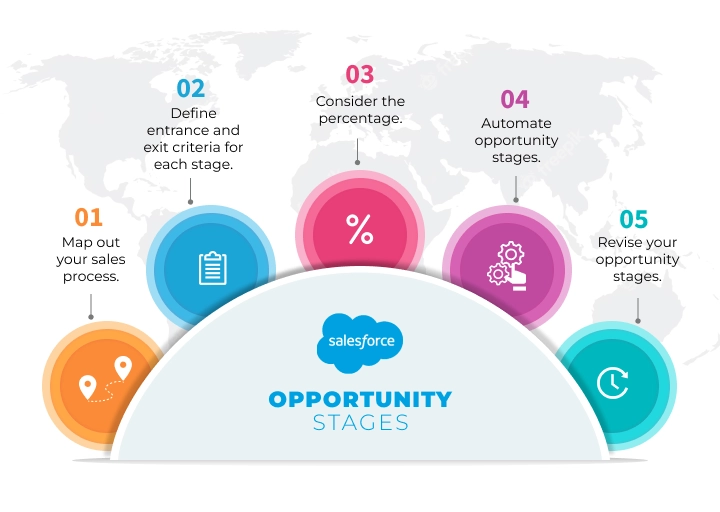One of the many benefits of Salesforce is that it has a tab called “Opportunities” that makes sales processes clear. This tab has a list of all sales opportunities and their current statuses, making it easy to track each deal. So, instead of wasting valuable time updating a spreadsheet, sales managers can keep track of deals in real-time and close them more quickly. Many companies that still use the Salesforce Opportunities tab “as is” miss out on the chance to boost their sales productivity by customizing it the right way.
Table of Contents:
1. Why Customize Salesforce Opportunity Stages?
2. Customizing Opportunity Stages: 5 Steps to Follow
2.1 Customized Opportunity Stages: The Foundation of Accurate Revenue Forecasts
2.2 Finding the Right CRM System for Flexible Opportunity Management
2.3 Maximizing Sales with Customized Opportunity Stages

Why Customize Salesforce Opportunity Stages?
Out-of-the-box Opportunity from Salesforce The stages are the most important parts of a generic sales process, which includes the following steps:
- Prospecting
- Qualification
- Needs Assessment
- Value Proposition
- ID Deciders
- An Analysis of Perceptions
- Proposal/Price Quote
- Negotiation/Review
- Won Closed
- Lost Closed
We’ve found that these standard stages rarely match the sales cycles of individual companies. For example, companies with long, complicated sales cycles and frequent customer contact may need more opportunity stages or want to change the names of the stages. With these changes, opportunity stages will be more relevant to the sales process of each company and easier for sales managers to understand. On the other hand, a company with a simple sales process might find that the same list of opportunity stages is too long.
We made a list of things you can do to customize your Salesforce Opportunity Stages to help you get the most out of Salesforce and increase its return on investment.
Customizing Opportunity Stages: 5 Steps to Follow
Step 1: Map out your sales process.
The first step is to define the specific phases of your sales process and determine which stages should be reflected in your Salesforce Opportunity Stages. This involves considering which of the standard stages fit your sales process and which ones need to be customized to avoid complexity and confusion for sales managers.
Step 2: Define entrance and exit criteria for each stage.
Opportunity stages are not one-off milestones, but instead, represent a phase in the sales cycle with several tasks to be completed before moving to the next stage. Therefore, each stage should have a picklist of activities that help sales managers to reach the next stage faster. For instance, to move from “Qualification” to “Needs Analysis,” a sales manager should complete tasks like holding the first meeting and generating a list of requirements.
Step 3: Consider the percentage.
As a deal progresses through the opportunity stages, the probability of making a sale increases. Thus, companies should assign a particular stage percentage based on the probability of closing a deal in each phase. Customize your probabilities based on historical data to ensure that your sales process reflects the level of confidence and actual state of things in your company.
Step 4: Automate opportunity stages.
Automation is one of Salesforce’s powerful features that saves time and effort. By automating opportunity stages, you can ensure that crucial information is not missed, and the sales team is not bogged down with manual data entry. Automation can be achieved through code means, which is available in the Enterprise edition of Salesforce.
Step 5: Revise your opportunity stages.
Finally, sales processes evolve, and it’s essential to revisit your sales process periodically to ensure that your opportunity stages are still relevant. By revising your stages, you can ensure that your sales process stays aligned with your business goals and objectives.
Customized Opportunity Stages: The Foundation of Accurate Revenue Forecasts
With Salesforce CRM, you can make Opportunity Pipeline reports that show the whole open pipeline arranged by stage and likelihood. From what I’ve seen, these reports are very important for any business because they help plan cash flows and income for the future. So, if a company adjusts its opportunity stages to fit its own sales process, it can see more of its pipeline and make more accurate predictions about how much money it will make in the future.
Finding the Right CRM System for Flexible Opportunity Management
Microsoft Dynamics 365 Sales have a lot of ways to set up, and a sales team can easily change an opportunity pipeline to fit the way they work. Also, with predictive opportunity scoring, they can put opportunities in order of how likely they are to lead to a sale and how much profit they will bring in. Dynamics 365 is good at more than just managing opportunities when it comes to sales management. Check out our Dynamics 365 services to learn more about this platform and get a general idea of whether it will meet your needs.
Maximizing Sales with Customized Opportunity Stages
I am sure that out-of-the-box opportunity stages are only good as a place to start. The Salesforce Customer Success Metrics Survey says that companies should customize and automate to get a 28% increase in revenue. Salesforce Sales Cloud was made just for that purpose.
With point-and-click tools, you can change a lot. But it only supports your business processes at a high level, which is rarely enough. To consider all the details (which is important for sales productivity), you’ll need to customize the Apex code more deeply, which may be hard to do in-house. The consultants and developers on Etelligens’s Salesforce team would love to show you how to get more out of your Salesforce licenses. If you want to know more, you can send us a request.